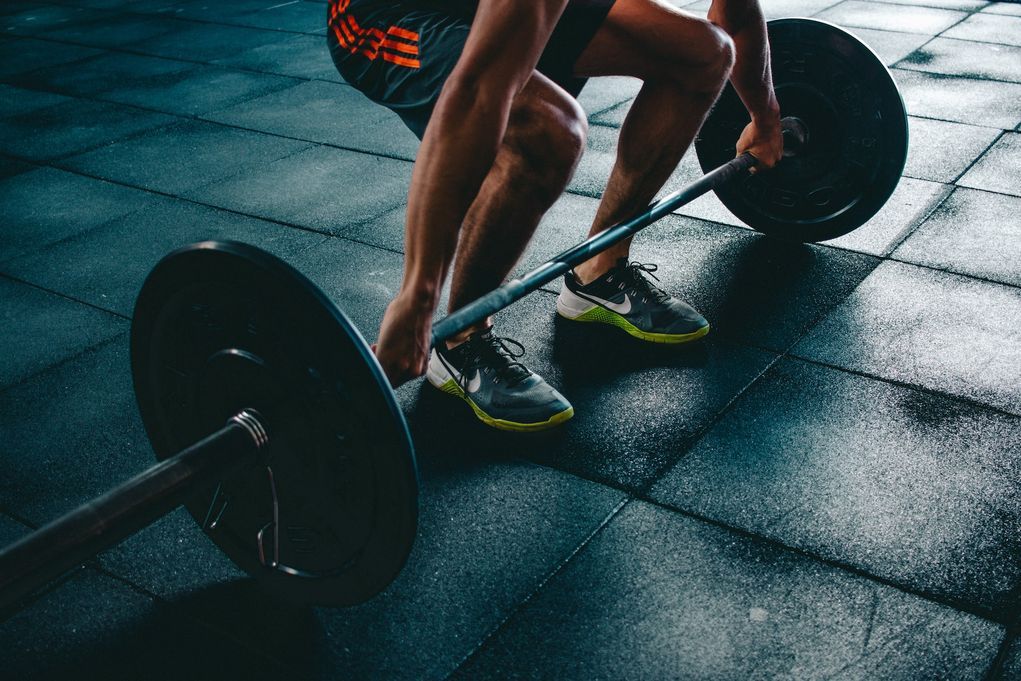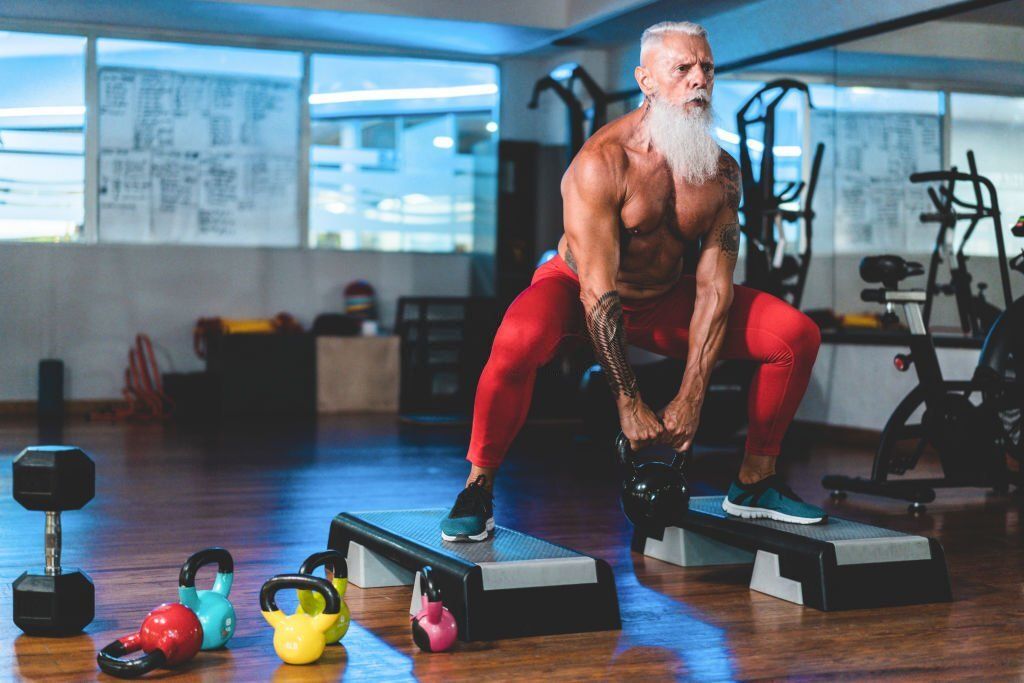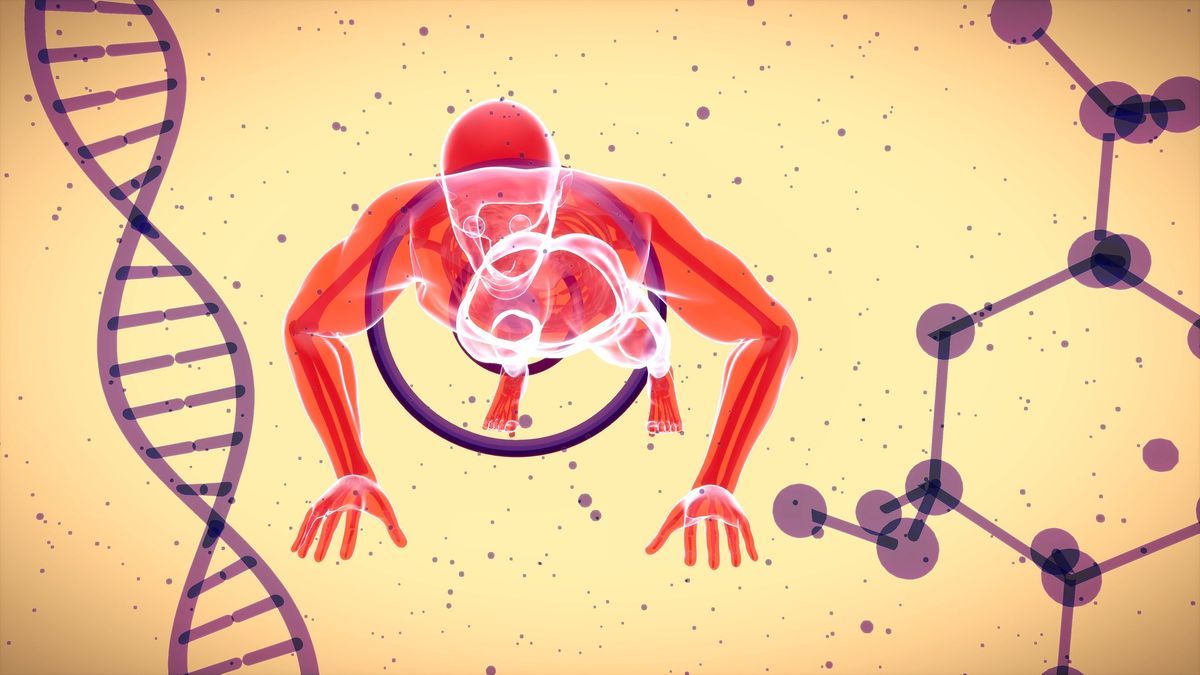There is a lot of myth associated with exercise and strength training after 40, 50, or 60. Some people believe that as our body age, we no longer get the same benefit from strength training or other forms of exercise. Some to the extent that it may be even harmful.
Thankfully there is a lot of scientific research to establish the importance of exercise during middle age and makes the point that although you no longer have the body of a 20-year-old, exercise that makes you stronger and gets you into shape is more important now than when you were younger.
Being stronger and more physically fit is essential to maintaining a good quality of life and keeping your independence as you mature.
If you are over the age of 40 and are committed to getting into shape whether it’s for the first time or you want to return to the physical condition of when you were younger, you have taken an important first step.
The benefits of weight training and other forms of resistance exercises, along with keeping up aerobically through cardiovascular training, are considerable for those who are over 40, 50, or more.
- Muscles burn more calories compared to body fat even when you are at rest. This can offset the effects of middle-age slowing of your metabolism and make it easier to keep extra pounds from adding up.
- Consistent exercise is credited with helping to slow or prevent the onset of life-threatening diseases that may begin in middle- age, including hypertension, strokes, atherosclerosis and other types of heart disease, diabetes, osteoporosis, and certain types of cancer.
- Strength and fitness training are believed to slow the progression of Alzheimer’s disease and other forms of dementia as well as the cognitive decline that slows down the brain’s usual sharpness.
These are the concerns that we’ll address in this article and will guide you in how to know yourself, build up yourself, and protect yourself.
Know Yourself

You must know yourself and your body for your strength training over age 40. As you ramp up your motivation and commitment, it is important to pause for a moment and take stock of who you are at this point in your life.
Your body is no longer that of a teenager or young adult because with the years come physical changes. Some are due to inevitable wear and tear from life’s stresses while others are results of the aging process.
Your muscles are gradually atrophying, ligaments, joints, and tendons are not as flexible, and your resilience is slower, meaning it takes you longer to recover after hard exertion. Your body shape may have changed, and your midsection may be getting larger.
Other, more subtle changes may be quietly working behind the scenes and slowing down your metabolism, which is the overall rate of your body’s functioning.
All of this adds up to you not being able to pick up where you left off and lift weights and do intense exercise like you used to.
But it is certainly not too late to return to a full exercise and fitness program focusing on weightlifting.
You can slow the aging process through exercise and diet, rebuild lost muscle mass, build new, larger muscles, and gain appreciable strength.
Restoring your body to earlier strength, building new muscle mass, increasing flexibility, getting your weight down, and keeping your arteries clear to slow the onset of cardiovascular disease.
Benchmarking 1: Measuring Up
Assessing your current condition is the best way to objectively determine where you are physically right now before beginning your weight training and overall physical improvement program.
The first stage of this benchmarking assessment is how you look and measure up.
The mirror, the scale, and the tape measure are impartial judges of how well you are doing and can help you set goals for where you want to go.
Begin by looking in the mirror while in your underwear and objectively consider how you look.
Don’t be hard on yourself– just take an estimate of where you are now and consider it a benchmark, a starting point. Check out your upper arms– how firm and defined are the biceps upfront, and the triceps behind?
Are your chest muscles, the pectorals or “pecs,” starting to sag? Next, is there any definition of your abdominal muscles or sign of the famous “six-pack” of well-developed abs? Finally, how about your thighs and calves?
If you stand sideways and lower yourself partially in a half-deep-knee bend, can you see any definition in your legs?
Make a mental note of what you see or, even better, write it down.
Step on the scale, preferably before breakfast, after your first pee in your underwear, barefoot, and at the same time and condition each day.
After noting your weight on the first day, go online and check your Body Mass Index (BMI), which is based on your height and weight.
A BMI of 18.5 to 24.9 is normal, 25 to 29.5 is overweight, and 30 and higher is considered obese.
Don’t be upset if you are overweight or obese — two-thirds of American adults are, but make a commitment that you will work to get that weight down close to the normal range. It’s important:
According to the CDC, the higher a person’s BMI, the greater the risk for diseases, including type 2 diabetes, heart disease, high blood pressure, respiratory problems, gallstones, and certain types of cancer.
- Be patient: it took time to gain the extra weight, so it will take time to get rid of it. Your diet will play a key role along with exercise, so be sure to give the upcoming chapter on the diet your fullest attention.
- The tape measure is the last appearance and physical measurement benchmark, and like the scale, it is completely objective. It doesn’t lie, exaggerate, or coddle you.
- Measure your waistline at the level between the top of your hip bones and naval, pulling the tape firmly but not too tight. Exhale just before you measure. Be aware that the measure for a man should not exceed 40 inches (102 cm), and for a woman, it’s 35 inches (89 cm).
Beyond those measurement limits, professionals say there’s too much belly fat, and that can interfere with numerous bodily functions. It also can possibly lead to the same diseases as an elevated BMI.
Benchmarking 2: Measuring Strength
The second phase of your benchmarking assessment is to see how much strength you have. A licensed physical trainer can run you through a series of measurements with different exercises and may even take a calculation of body fat and lean muscle percentages.
But you can take your own simple strength measurement by dropping down and seeing how many push-ups you can do. Start in a plank position, legs extended to the rear, arms fully extended shoulder-width apart, and your back level (no sagging or arching).
Lower down fully so your nose or chest touches the floor, raise back up to the starting position, and repeat as many times as you can. Don’t race: take about three seconds for each down-and-up cycle. Write down your total.
If you have access to a pull-up or chin-up bar, count how many pull-ups you can do (a pull-up is with your palms facing forward).
Place your hands shoulder-width apart and pull up fully, lower all the way down ((not too fast), and repeat as many times as you can in good form (no half-ways).
When you’re done, write down the total. Or, if you can use dumbbells, determine the maximum weight you can curl eight to 10 times maximum. A curl is raising the dumbbells from the arms-lowered position up to your shoulders, then slowly lowering back down.
As your weight training program progresses, you can periodically repeat these exercises and measure your improvements.
Fitness, Health, Longevity
Your motivation to get into, or get back into, weightlifting and other exercises to gain strength in middle age is based, at least in part, on how you want to look and feel. You want to see a well-built body in the mirror with visibly larger, defined muscles and a flatter gut.
You want to feel the muscles expanding under your skin at the end of your workouts as blood rushes to the hard-working muscle cells and fibers in the “pumping iron” effect.
You want more energy, more bounce to your step, and more endurance to keep you going longer. You want to look and feel fit. You want to be stronger.
These are the motivating factors that will get you started on your weight and strength-building program. They hopefully will be enough to keep you going because achieving your fitness goals will take time and effort.
To further reinforce your commitment, let’s pick up on what was mentioned above in the discussion of benchmarking — the health aspects of getting in shape and staying in shape, and getting your weight down and keeping it down.
More Life to Your Years
There’s an expression that was popular among long-distance runners and has spread to the weightlifting and fitness community overall:
“Working out and staying in shape will add more life to your years and may even add more years to your life.”
In other words, your commitment to building muscle and getting into good cardiovascular condition definitely will make every day richer and more vibrant and may also help you to live longer.
All in all, that’s not a bad deal. It gives you something to work for, invest time and energy in, and stay with over the long term.
According to the Mayo Clinic (2020), regular exercise can improve health and manage the symptoms of chronic illnesses that are long-term, limit activities, and interfere with a normal lifestyle.
Strength training with weightlifting not only improves muscle strength and increases endurance, but makes daily activities easier to do and slows the decline in muscle strength related to the disease.
Every day, we are lifting, carrying, standing, walking, crouching, bending, and generally challenging our muscles, joints, bones, and tendons as well as pushing our circulatory and respiratory systems as we work our hearts and lungs during exertion.
The better the state of our physical condition, the easier the work we do will be, and when we’re in good shape, we feel better.
Joint stability
Flexibility exercises can help you regain an optimal range of motion by providing stability to your joints to enhance their functionality, and the risk of falls can be reduced with stability exercises.
Weightlifting and other resistance exercises, when done correctly, will increase stability and flexibility and will further help by strengthening the muscles that support the joints.
For example, by strengthening the quadriceps muscles at the front of our thighs, we can help control the kneecap and knee socket, preventing excess motions that can wear away the cartilage that lubricates and cushions the knees.
Diabetes. Regular exercise can lower the risk of adult-onset type 2 diabetes by enabling insulin to lower blood sugar levels more effectively.
For those already with type 2 diabetes, resistance exercise with weightlifting, along with aerobics, can reduce the risk of heart disease.
Type 2 diabetes is often associated with obesity, so the weight reduction benefits of exercise can directly reduce the risks and symptoms of diabetes.
Weight control. Physical activity can help you control your weight and boost your energy because weightlifting burns calories as does cardiovascular training.
However, exercise alone does not optimize weight loss; it is the combination of diet and exercise that is most effective.
Diet and exercise combined can make the greatest effects in getting those excess pounds off and keeping them off.
Arthritis
Exercise has been found to reduce joint pain, maintain muscle strength in arthritis-affected joints, and reduce stiffness in joints, resulting in improved quality of life and physical function even for those who have been suffering from arthritis for years.
Those with arthritis symptoms should choose low-impact exercise. Any weightlifting that puts extra pressure on joints may require modifying certain movements to reduce the strain.
Asthma.
The heavy, deeper breathing associated with weightlifting and all intensive exercise appears to help reduce the severity and frequency of asthma attacks.
The depth of breathing during exercise, combined with increased blood circulation and oxygen delivery, may strengthen the lungs and air sacs where oxygen is transferred to the bloodstream.
The deep breathing performed during intense exercise also strengthens the diaphragm muscle, which controls breathing by facilitating inhaling and exhaling.
Back pain
Abdominal and core-challenging resistance exercises strengthen the muscles around your spine, and these exercises may help reduce back pain symptoms.
Also, low-impact aerobic exercises, performed regularly, are believed to increase strength and endurance in the back and improve the function of the lumbar and thoracic back muscles.
Bone density. Our bones are porous, which is normal. But as we enter middle age, this porosity can increase, and the bones become less dense, more brittle, and more susceptible to breakage. This condition is called osteoporosis.
Falls are a common cause of bone fractures, but there are others, too, including some that are exercise-induced.
Running or jumping on a hard surface, for example, may cause small stress fractures, which are hairline cracks in the bones that can cause pain and lead to larger breaks.
The right kinds of exercise, however, can help reverse osteoporosis and make bones stronger:
- High-impact, weight-bearing exercises include activities like dancing, jumping rope, running, and jogging outdoors (with proper athletic shoes to prevent injury), hiking (especially uphill), and playing tennis or racquetball.
- Low-impact, weight-bearing exercises may be better for those already diagnosed with osteoporosis and include working out on elliptical machines or stair climbers and walking at a brisk moderate pace either outdoors or on a treadmill.
- Muscle-strengthening exercises include weightlifting with free weights, like dumbbells and kettle weights, weight machines with cable-pulled weights, stretching elastic exercise bands, or performing bodyweight calisthenics. Flexibility exercises can involve stretching (especially after a workout), yoga, and Pilates.
- Yoga is especially recognized for improving flexibility and balance, which can help prevent falls. If you already have osteoporosis concerns, it’s a good idea to check with your doctor or a trained professional physical therapist to make sure you are not straining body parts that are at risk.
Mental health
Exercise reduces symptoms of two of the most common mental and emotional concerns: anxiety and depression. Both of these conditions are frequently caused by stress, which triggers the body’s sympathetic response, the well-known “fight or flight” reaction to perceived dangers.
The body gets ready for action with elevated heart and breathing rates as well as the release of the energy hormones, adrenaline, and cortisol.
In this charged state, anxiety can occur, and when it is continuous over time or chronic, it can lead to autoimmune responses, including chronic inflammation.
Resistance or cardiovascular exercise takes advantage of the body’s state of readiness by effectively putting energy hormones to work and burning the extra glycogen they have sent to your muscles.
When the workout is over, and you have cooled down, heart and breathing rates return to normal.
The workout also will release beta-endorphin hormones that give you a feeling of elation, and the anxiety can be dissipated.
Depression can occur when the parasympathetic response, which cools things down, overdoes it, reducing normal energy levels and depressing the central nervous system.
As with anxiety, beta-endorphin hormones can give the person a sense of elation, and the depressive state can be reduced or eliminated.
Caveat: Chronic anxiety and depression may not respond sufficiently to exercise, meditation, or yoga, and in those cases, professional care may be necessary.
Dementia
Cognition disorders, especially in people with dementia, may be reduced by exercise.
Moreover, those not currently suffering from dementia, and who are physically active regularly with resistance and aerobic exercises, are at reduced risk of developing cognitive impairment and dementia or appreciably slowing its onset.
Cancer
Can the right exercise routines prevent cancer? There is evidence, as the Mayo Clinic reports, that exercise can lower the risk of dying from prostate, breast, and colorectal cancer, and exercise may also help reduce the likelihood of developing other forms of cancer.
Exercise may also improve the quality of life and overall fitness of those who have recovered from cancer.
Many doctors believe that exercise’s role in lowering weight and reducing the likelihood of other diseases keeps the immune system strong, and this helps prevent cancer cells from proliferating, forming tumors, or metastasizing (spreading).
Heart Health
The prevention of heart disease is closely associated with exercise, and with good reason. Exercise can play an important role in preventing heart disease or reducing its risks.
Both of the major categories of exercise, resistance and cardiovascular, when performed for sufficient time and with sufficient intensity, can improve
overall heart healthiness and contribute to the prevention of heart attacks, heart failure, and strokes.
Heart disease includes atherosclerosis, the build-up of plaque in the coronary arteries that supply the heart with oxygen-rich blood.
Over time, as the plaque accumulates, the flow of blood to the heart becomes restricted.
Early warnings include angina pectoris, which is a pain in the chest during exercise. Preventing or limiting the build-up of plaque is directly related to controlling the levels of blood lipids.
Can exercise lower blood lipids?
The results of studies are encouraging within limits. Blood lipids include HDL (good) cholesterol, which is credited with carrying away LDL (bad) cholesterol, and the low density, sponge-like blood lipid which can add to the plaque that clogs arteries, leading to atherosclerosis or coronary heart disease.
Another major blood lipid group is triglycerides, which are fats that circulate in the bloodstream and also can lead to heart disease.
Studies that show exercise-induced reductions of LDL cholesterol and triglycerides and elevated beneficial HDL cholesterol indicate that the intensity of exercise is a key factor.
Whether it’s weightlifting or aerobics, the workout needs to get the heart rate up and keep it up for at least 25 to 40 minutes three or more times per week.
Controlling hypertension. Exercise can also contribute to lowering hypertension, or high blood pressure, which is a primary cause of strokes.
- Exercise and high blood pressure are connected because your heart grows stronger with regular, consistent physical activity. When your heart is stronger, it can pump more blood volume with less exertion. As a result of your heart working less to pump blood, your blood pressure is lowered as the pressure on your arteries is reduced.
- Exercise has been clinically proven to lower systolic blood pressure (the first number in your blood pressure reading) by four to nine millimeters of mercury (mm Hg). So, with the right exercise, a systolic pressure of 135 could be lowered to 126, which is within the normal range, and about the same result as from some blood pressure prescription drugs. As a result, for some who have hypertension, regular exercise can reduce or replace a dependency on blood pressure medication.
- The benefits of exercise extend to those whose blood pressure is at normal levels, which is less than 130/ 80 mm Hg. Exercise can help keep your blood pressure from rising as you grow older. Helping you to keep your weight down and maintain a normal BMI is another way exercise helps you to control blood pressure.
- Resistance training has also been demonstrated to help protect cardiovascular health. In B M C Public Health (2012), researchers reported that the combination of resistance and aerobic exercise was effective in helping people lose more weight and fat than either of these exercise techniques alone as well as creating increased overall cardiovascular fitness.
- The lipid-lowering benefits of resistance training for people with high overall cholesterol were cited in the medical journal Atherosclerosis (2011), showing that those who performed resistance training cleared LDL cholesterol from their bloodstream faster than those who did not train.
High-intensity interval training is generally safe and effective for most people and can take less time. In high-intensity interval training, you alternate exercising at high levels of intensity and exercising at a less intense level for short periods. Even activities such as walking at higher intensities count.
Low-intensity exercise is valuable for helping to lower your weight and to relieve stress, and some studies suggest that even walking at a moderate pace for 150 minutes a week can have positive cardiovascular and overall health benefits.
This intensity and duration is an alternative to the frequently recommended 75 minutes per week of intense exercise.
Post-coronary exercise is generally recommended to aid recovery and strengthen the heart, which is a muscle, and like all muscles, benefits from regular exercise.
In these cases, the type and intensity of the exercise should be medically supervised.







